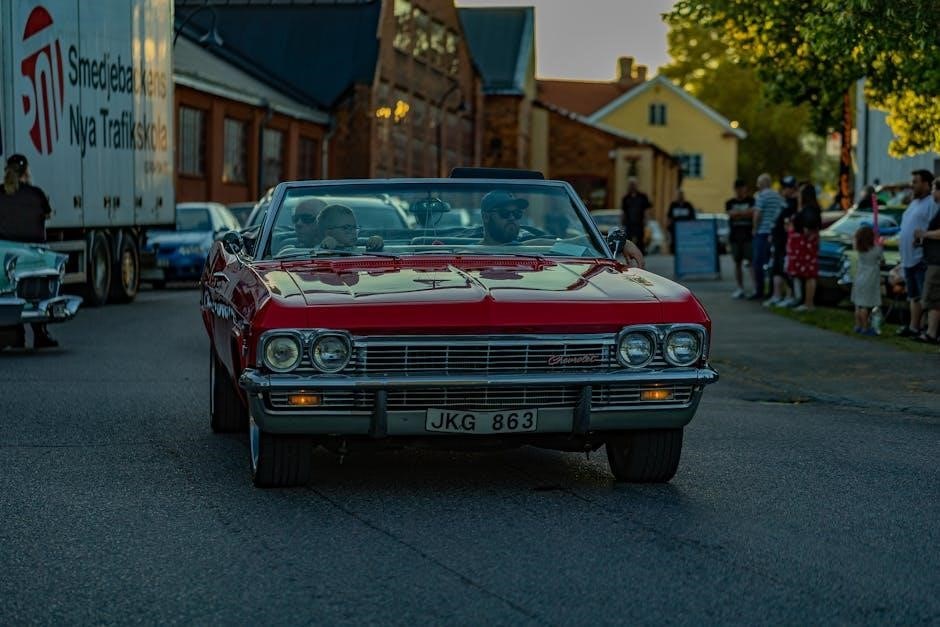Louise Erdrich’s The Red Convertible is a poignant tale of brotherhood, cultural identity, and resilience, set against the backdrop of reservation life and historical change.
Overview of the Story and Its Significance
Louise Erdrich’s The Red Convertible is a deeply moving short story from her acclaimed collection Love Medicine. It centers on the relationship between two brothers, Henry Junior and Lyman, and their iconic red Oldsmobile. The car symbolizes freedom, joy, and their unbreakable bond. However, the story takes a tragic turn when Henry Junior returns from war, forever changed. Through this narrative, Erdrich explores themes of brotherhood, cultural identity, and the impact of historical events on individual lives. The tale resonates as a powerful exploration of family, loss, and resilience, making it a cornerstone of contemporary Native American literature.
Background of Louise Erdrich and Her Work
Louise Erdrich, a celebrated Native American author, was born in 1954 in Little Falls, Minnesota. Her heritage is deeply rooted in the Ojibwe people, a fact that profoundly influences her writing. Erdrich is best known for her novels and short stories that explore themes of family, cultural identity, and the historical experiences of Native American communities. Her work often intertwines myth, history, and contemporary life, creating rich, layered narratives. A key figure in Native American literature, Erdrich has received numerous accolades for her contributions to storytelling and cultural preservation. Her writing continues to captivate readers with its emotional depth and cultural resonance.
Themes in “The Red Convertible”
The story explores themes of brotherhood, cultural identity, and personal resilience, delving into the emotional and historical challenges faced by Native American communities.
Brotherhood and Family Ties
The story highlights the deep bond between Henry Junior and his brother, illustrating the strength of family ties amidst personal and cultural challenges. Their shared experiences, particularly their adventures with the red convertible, symbolize loyalty and mutual support. The car serves as a metaphor for their relationship, representing freedom, joy, and a connection to their heritage. Through their interactions, Erdrich portrays the emotional journey of two brothers navigating life’s difficulties, emphasizing the transformative power of sibling bonds. The narrative underscores the importance of kinship in fostering resilience and understanding in the face of adversity.
Cultural Identity and Reservation Life
Louise Erdrich’s The Red Convertible offers a vivid portrayal of life on a Native American reservation, exploring themes of cultural identity and the struggles faced by its characters. The story delves into the daily challenges of reservation life, highlighting the tension between tradition and modernity. Through the protagonist’s experiences, Erdrich examines the complexities of maintaining cultural heritage in a rapidly changing world. The red convertible itself becomes a symbol of freedom and escape, yet it also underscores the constraints imposed by societal expectations and historical circumstances. The narrative provides a poignant reflection on the resilience of Native American communities and their enduring connection to their roots.

Cultural Significance of the Story
The Red Convertible holds deep cultural significance, reflecting Native American experiences, identity struggles, and resilience. It symbolizes freedom and heritage, resonating with broader societal themes and historical contexts.
The Role of the Red Convertible as a Symbol
The red convertible in Louise Erdrich’s story serves as a powerful symbol, representing freedom, joy, and the bond between the two brothers. It embodies their shared aspirations and youthful energy, becoming a central element in their relationship. The car’s vibrant color and convertible design signify a longing for escape and adventure, contrasting with the harsh realities of reservation life. However, as the story progresses, the car also symbolizes loss and transformation, reflecting the broader themes of cultural identity and personal growth. Its presence and eventual decline mirror the characters’ emotional journeys, making it a profound and enduring symbol in the narrative.
Representation of Native American Experiences
Louise Erdrich’s The Red Convertible offers a vivid portrayal of Native American life, delving into the challenges and complexities faced by indigenous communities. The story highlights the struggles of reservation life, exploring themes of identity, tradition, and resilience. Erdrich’s narrative provides insight into the emotional and social dynamics within Native American families, reflecting the broader historical and cultural context. Through the characters’ experiences, the story underscores the enduring strength of Native American culture while addressing the hardships imposed by external forces. This representation adds depth and authenticity to the narrative, making it a significant work in Native American literature.

Literary Devices and Style
Louise Erdrich employs vivid imagery, symbolism, and a non-linear narrative structure in The Red Convertible. The red car symbolizes freedom, brotherhood, and cultural identity, enriching the story’s emotional depth.
Narrative Structure and Point of View
The story is narrated by Lyman Lamartine, offering a personal and introspective viewpoint. The narrative structure is non-linear, blending past and present to reveal the brothers’ bond and their shared struggles. Lyman’s perspective provides emotional depth, allowing readers to connect with the characters’ experiences. The use of first-person narration enhances the authenticity of the tale, making the events feel deeply personal. This structure also highlights the cultural and historical context, emphasizing the impact of external events on their lives. The narrative’s flow mirrors the unpredictability of life, reflecting the characters’ journeys and transformations effectively.
Use of Imagery and Symbolism
The red convertible serves as a powerful symbol of freedom, brotherhood, and cultural identity. Imagery of the car’s vibrant color and its journey across landscapes evokes a sense of adventure and shared experiences. Erdrich’s vivid descriptions of the reservation and natural settings create a stark contrast between tradition and modernity. Symbolism is woven throughout the story, with the car representing both joy and tragedy, reflecting the characters’ emotional journeys. The deterioration of the convertible mirrors the brothers’ evolving relationship and the broader challenges faced by their community. These elements enrich the narrative, offering layers of meaning and emotional resonance.

Historical Context
The story is set against the backdrop of significant historical events impacting Native American communities, reflecting the challenges and changes faced during this period.
Setting and Time Period
The story is set on a Native American reservation in the late 20th century, specifically during the 1970s. This time period is marked by significant historical events, such as the Vietnam War, which deeply impacts the characters, particularly Henry Junior. The reservation setting highlights the challenges and changes faced by Native American communities, reflecting themes of cultural identity and resilience. The narrative structure emphasizes the emotional and societal shifts during this era, creating a vivid backdrop for the story’s exploration of brotherhood, loss, and transformation. The setting plays a crucial role in shaping the characters’ experiences and the overall mood of the story.
Impact of Historical Events on the Story
The story is deeply influenced by historical events, particularly the Vietnam War, which shapes the lives of the characters. Henry Junior’s transformation after returning from the war reflects the broader societal impacts of the conflict. The red convertible, once a symbol of freedom and joy, becomes a reminder of lost innocence and the scars of war. The reservation setting also underscores the historical struggles of Native American communities, adding another layer of complexity to the narrative. These historical influences weave together to create a poignant exploration of loss, resilience, and the enduring bonds of family and culture.

Character Analysis
The story delves into the complex dynamics between Henry Junior and his brother, exploring themes of loyalty, identity, and personal growth amidst challenging circumstances.
Henry Junior and His Transformation
Henry Junior undergoes a profound transformation, evolving from a carefree youth to a traumatized veteran. His journey reflects the broader struggles of Native American identity and resilience, shaped by cultural disconnection and personal loss. The red convertible serves as a symbol of his shifting identity, representing both freedom and the weight of responsibility. Through his story, Erdrich highlights the lasting impacts of historical events and the enduring strength of familial bonds. Henry’s transformation is a powerful exploration of individual and collective experiences, offering a poignant commentary on the challenges faced by Indigenous communities.
The Protagonist’s Journey and Growth
The protagonist’s journey in The Red Convertible is a deeply personal exploration of identity, loss, and resilience. As the narrator navigates the complexities of brotherhood and cultural heritage, the story unfolds as a metaphor for transformation. The red convertible acts as a catalyst, symbolizing freedom and shared experiences, while also reflecting the fragility of life. Through the protagonist’s eyes, the reader witnesses the impact of external forces on individual growth, culminating in a poignant realization of the importance of family and tradition. This journey underscores the universal struggle to find one’s place in a changing world.
The Title and Its Meaning
The red convertible symbolizes freedom, brotherhood, and cultural pride, while also embodying the fragility of life and the passage of time.
Significance of the Red Convertible
The red convertible in Louise Erdrich’s short story is a powerful symbol of freedom, joy, and the bond between the two brothers, Henry Junior and the narrator. It represents a shared dream and a connection to their cultural heritage. The car’s journey mirrors the characters’ lives, reflecting their struggles, transformations, and ultimate resilience. Its vibrant color and presence evoke a sense of pride and identity, while its eventual decline symbolizes the fragility of life and the passage of time. The convertible becomes a metaphor for the fleeting nature of happiness and the enduring strength of brotherhood in the face of adversity.

Downloading “The Red Convertible” PDF
The story is available in PDF format through various online platforms, including educational databases and literary websites, ensuring easy access for readers worldwide legally.
Guide to Finding the Story Online
To find The Red Convertible in PDF format, visit academic databases like Google Books or Project Gutenberg. Use specific search terms such as “The Red Convertible Louise Erdrich PDF” for accurate results. Check university libraries or online archives, as they often provide free access to literary works. Additionally, platforms like Scribd or ResearchGate may host user-uploaded versions. Always ensure the source is legitimate to avoid copyright issues. For convenience, use advanced search filters to narrow down results by publication year or file type. This approach streamlines your search and ensures quick access to the story.

Book Review and Reception
Critics and readers acclaim The Red Convertible for its poignant exploration of brotherhood, cultural identity, and resilience, marking it as a timeless and deeply moving narrative.
Critical Acclaim and Reader Responses
Louise Erdrich’s The Red Convertible has received widespread critical acclaim for its emotional depth and cultural insights. Readers praise its nuanced portrayal of brotherhood and loss, resonating deeply with its themes of identity and resilience. The story’s ability to blend personal narrative with broader cultural commentary has made it a landmark in contemporary Native American literature. Many reviewers highlight its vivid imagery and the symbolic significance of the red convertible, which serves as a powerful metaphor for freedom, connection, and transformation. The story’s relatability and emotional impact have sparked meaningful discussions among readers, cementing its place as a timeless and thought-provoking work.
The Red Convertible is a profound exploration of brotherhood, cultural identity, and resilience. Its emotional depth and universal themes leave a lasting impact, resonating deeply with readers.
Final Thoughts on the Story’s Impact
The Red Convertible leaves a lasting impression, exploring themes of brotherhood, loss, and cultural identity. The story’s emotional depth resonates deeply, offering insights into the struggles and resilience of its characters. The red convertible, as a symbol, embodies freedom and transformation, reflecting the broader struggles of Native American communities. Erdrich’s narrative masterfully weaves personal and collective experiences, creating a story that is both poignant and universally relatable. Its impact lies in its ability to evoke empathy and reflection, making it a significant work in contemporary literature. The story’s legacy continues to inspire readers, highlighting the power of storytelling to capture the human condition.

